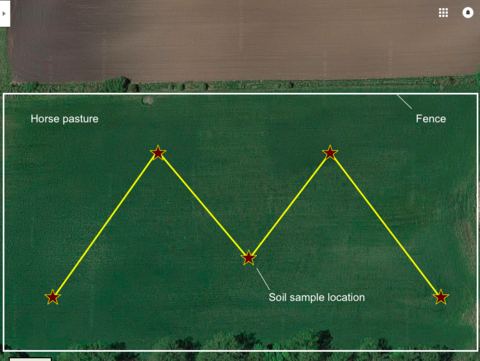-
Test your pasture soil to determine if and how much fertilizer your pasture needs.
-
You should test your pasture soil every three years.
-
You can send soil samples to the University of Minnesota Testing Lab or a private lab for testing.
-
Collect a separate soil sample from each unique area of pasture.
-
You can use a single soil sample for up to 20 acres of pasture if it’s consistent.
Why take a soil sample?
Soil tests analyze the nutrient levels in a soil sample taken from your pasture. This will help you determine if and how much fertilizer your pasture needs. The three major elements that affect plant growth are nitrogen (N), phosphorus (P) and potassium (K).
When to sample
You should test your pasture’s soil every three years. The best time to take a soil sample is in the fall but can be taken anytime the soil is relatively dry.
How to take a sample
Your local cooperative can take the soil test for you or you can send a sample to the University of Minnesota Soil Testing Lab (612-625-3101).
You can use one sample for up to 20 acres if your pasture area is consistent, similar in the following;
-
Soil type
-
Drainage capacity
-
Topography
-
Other
You will need to take a sample for each area if your pasture has dramatically different areas.
-
Collect a sample by walking in an “M” pattern and taking a sample at each point.
-
Use a shovel (or soil probe) to dig down 6 inches.
-
Remove the sod and place the soil in a bucket.
-
Repeat this for each “M” point
-
When finished sampling, mix the soil in the bucket.
-
Take a subsample (about a sandwich bag or 2 cups) to send to the lab
-
Repeat this process for each unique area of the pasture
For more information and to see a demonstration, watch our video on soil sampling.
Submitting samples
You can send soil samples to the Soils Testing Lab at the University of Minnesota or to a private lab.
For a University of Minnesota soil analysis, you can pick up a free soil test kit from your county Extension office. This kit includes bag(s) and a form that has additional instructions for soil sampling and where to mail it. Make sure you fill out the form completely and clearly state it’s a pasture soil sample.
When you receive the analysis it will list levels of the following;
-
Phosphorus
-
Potassium
-
Nitrogen
-
pH
-
Organic matter
You can use this information to select an accurate fertilizer mix. For cost and environmental concerns, it’s important to base your pasture fertility on a soil analysis.
Reviewed in 2021


